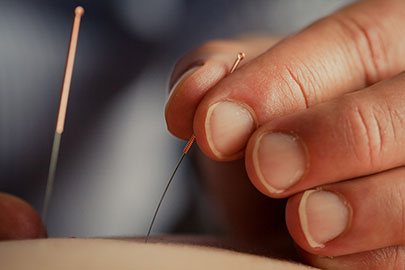
What is Acupuncture?
Traditional acupuncture is an ancient Chinese form of natural medicine that dates back approximately 5,000 years. It has developed from careful observation of the workings of the body and how the environment affects it. The principle behind the medicine is to view and treat the body, mind and emotions as a single unit, working on the cause of the illness, not the symptoms. In many countries it is a primary form of health care; in the hospitals in China it is used directly alongside Western Medicine.
Here is a simple analogy to get a basic understanding of how our body is viewed in Chinese Medicine:
Think of the body as a complex system of water pipes which need to be in good health for everything to work smoothly. When a blockage develops in a pipe somewhere it affects the workings of the entire system and generates symptoms. This is akin to what happens when an injury or disease affects our body. These “pipes” which run all over our body are called meridians. The “water” which flows through them is named Qi (Chi). The Chinese mapped out these meridians over the course of almost a thousand years. By inserting a needle into specific points along these pathways, the blockages can be removed and harmony returned to the body. Whilst several research studies are being performed to explain how Acupuncture works in a Western Medical Framework, these scientists have not yet been able to explain how it works exactly; however, they have provided solid evidence that acupuncture does in fact work very well.
The benefits of Traditional Chinese Medicine are:
- Drug-free pain relief without the side effects
- Boosts the immune system against disease
- Treats the cause as well as the symptoms
- Effectively treats many common ailments
- An all natural form of Medicine
- A good form of maintenance and prevention
- Can prevent chronic conditions from further deteriorating
How many treatments will you need?

The number of consultations needed is dependent on many factors such as the longevity and severity of the problem, as well as the constitutional strength of the patient. Traditionally in China patients are seen once a day for three weeks before sessions are spaced out weekly. This is possible largely due to the fact that Acupuncture is government funded. In Australia though this is not the case, nor with our busy lifestyles can be find time for daily treatments. However, I have found the following to be an average course of treatment which yields good results.
Ten treatments constitute one course.
The ideal scenario is as follows:
- The first 3 sessions are spread out over 1.5 weeks
- The next 5-6 sessions are weekly
- If relief is lasting more than a week, the final few sessions are spaced out fortnightly
- Then monthly check ups are performed
However some chronic conditions may require several courses before we can space the sessions several weeks apart.
What Can Acupuncture Treat?
Acupuncture has been proven to successfully treat a wide range of disorders. The chance of success is dependent on many factors such as the longevity and severity of the problem, as well as the constitutional strength of the patient. Dr Orloff can help you with any of the following conditions:
- Disorders of the Head and Neck
- Emotional Disorders
- Blood and Circulation Disorders
- Respiratory Disorders
- Digestive Disorders
- Urinary and Bowel Disorders
- Menstrual and Pregnancy Disorders
- Sexual Disorders
- Skin Disorders
- Musculo-Skeletal Disorders
- Auto-immune Diseases
- Neurological Disorders
And many more…
What Techniques are used?
Acupuncture
The needles used in acupuncture are very different to the hypodermic needles used in Western Medicine. Acupuncture needles are not hollow and they do not slice through skin and muscles. Instead, they have a conical shaped tip, parting the skin and muscle as the needle glides into the acupuncture point. This means that there is little to no discomfort when the needle is inserted. Acupuncture needles are single-use and sterile, and they are made of stainless steel. Therefore they do not break or cause infection.
Moxibustion
This is the process whereby a small bundle of herb is burnt either on the end of the needle or over the skin of an acupuncture point. This is used to put warmth into the channel to remove cold blockages, or for such conditions as “frozen shoulder”.
Cupping
Heat is placed inside a cup to create a vacuum which is then placed onto the skin creating a suction effect. This is used to remove toxins and old blood from sore muscles. As a result of this the skin may appear bruised at the site of cupping due to the toxins coming up to the surface. There is no discomfort and the marks will disappear after a couple of days.
Health Fund Rebates are Available
WorkCover Certified
